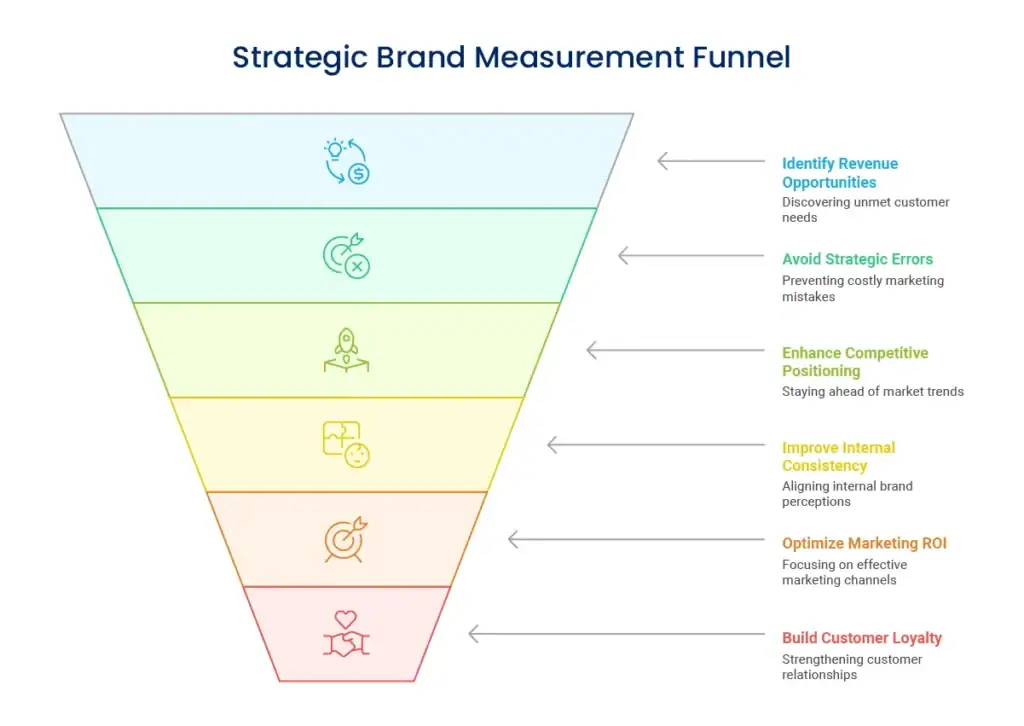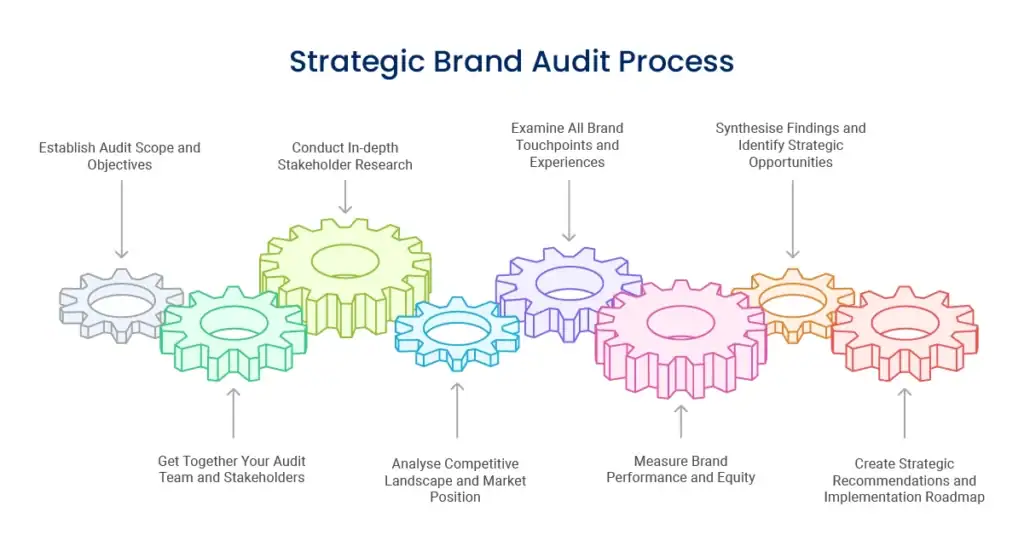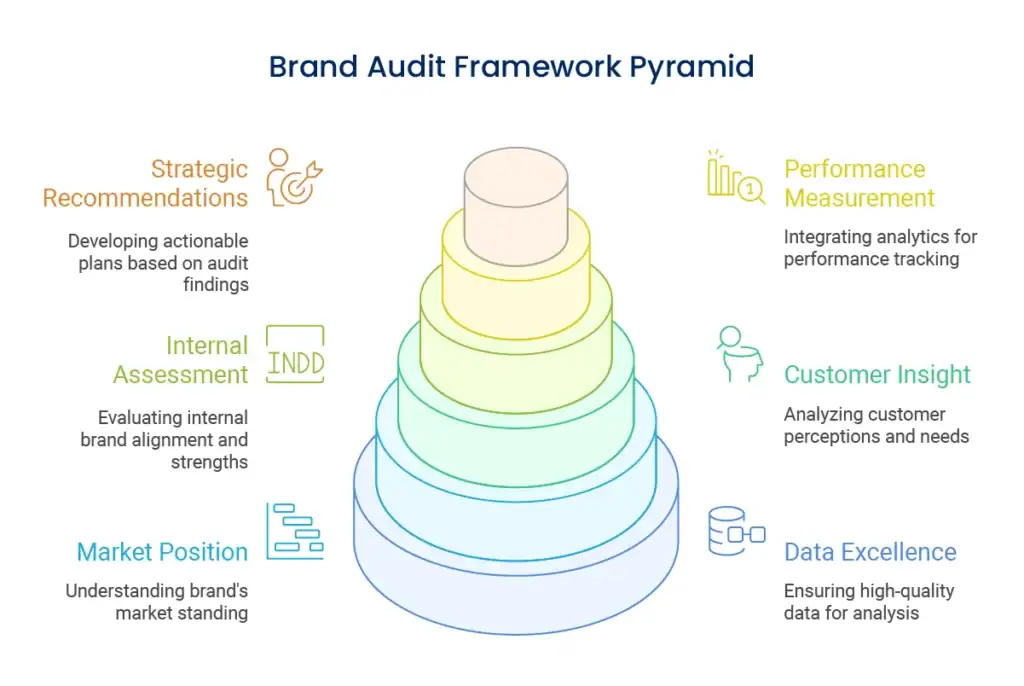Custom Design
Brand audit dilemmas keep business owners up at night. You’ve created something valuable, poured countless hours and money into it, and yet you don’t know if your brand really speaks to customers or distinguishes itself from others.
This ambiguity isn’t just awkward—it’s expensive. Without a precise sense of your brand’s current position, strengths, and gaps, you’re making strategic choices blindly. Every marketing pound invested, every campaign activated, every customer engagement occurs without the strategic insight that differentiates successful brands from struggling brands.
We’ll take you through an end-to-end methodology for doing strategic brand audits that turn fragmented insights into executable growth plans. You’ll learn how to methodically evaluate every element of your brand’s performance, from customer attitudes to competitive positioning, and translate that evaluation into tangible steps for enduring growth.

A brand audit is an extensive analysis process that rigorously analyzes your brand’s current standing, performance, and potential at every touchpoint and with all stakeholders. Consider it a complete health check-up for your brand—comprehensive enough to go deeper than surface-level data to reveal the underlying strategic insights driving business growth.
This isn’t a matter of making pretty reports or checking boxes. A strategic brand audit is your growth intelligence system, the data-driven underpinning for all big brand decisions that you’ll make. It looks at how your brand works in the real world, how actual customers experience you compared to how you’d like to be experienced, and where there are opportunities for meaningful differentiation and growth.
The procedure of doing this is gathering and analysing quantitative data (web analytics, social media metrics, sales figures) together with qualitative insights (employee feedback, market research, customer interviews). The combination provides an overall picture of your brand’s ecosystem—from internal brand alignment in your organisation through to external market positioning against competitors.
Above all, a brand audit is not a one-off process. It sets the benchmark for continuous strategic brand management and lays the groundwork for monitoring progress against your growth goals.

Knowing the actual position of your brand in the market is not a choice—it’s a prerequisite for long-term growth. Here’s why your company should make strategic brand measurement a priority:

A comprehensive audit exposes areas of mismatch between customer requirements and your existing offerings. These discrepancies are emerging revenue streams that your rivals may be overlooking as well. If you find out what customers desire but are not getting, you can create focused solutions which capture premium pricing.
Without proper understanding of how your brand is being perceived, you might be spending money on campaigns or programs that fail to speak to your customers. Brand audits prevent these costly errors by basing decisions on real customer data instead of guesses.
Regular review enables you to realize not only where you are relative to your competition, but also where the market is going. This knowledge enables you to place your brand in advance of trends instead of playing catch-up after your competitors have done so.
Brand audits frequently uncover inconsistencies between the way various departments perceive and talk about your brand. Resolving these internal discrepancies builds a more unified customer experience and more effective brand communication strategy.
By knowing which brand messages most resonate with your audience, you can concentrate your marketing budget on the most productive channels and themes. This focused effort generally generates 2-3 times greater return than scatter-shot campaigns.
Audits reveal what makes your customers emotionally connect. That knowledge allows you to deepen the relationships that lead to repeat business and word-of-mouth referrals—both essential to long-term profitability.
Systematic brand audit analysis calls for a formal framework that reviews all facets of your brand’s universe. The following are the building blocks on which true brand intelligence must be based:
Your audit quality hinges solely on the excellence of your data gathering. This means more than merely collecting simple metrics to creating robust research methodology that equally captures quantitative performance and qualitative facts.
Begin with internal data sources: sales data, customer service records, web analytics, social media engagement rates, and email marketing metrics. These give the baseline knowledge of how your brand performs in each channel and customer segment.
Outside research provides vital background. Customer surveys, focus groups, and interviews provide the difference between planned brand positioning and perception. Don’t confine yourself to existing customers—why prospects go to competitors can be extremely valuable intel for positioning strategy.
Market research tools and industry reports provide context to your performance across wider market trends. External look-through avoids the internal bias which distorts audit findings and ensures your evaluation mirrors actual market conditions.
Knowing your competitive environment demands more than simply identifying immediate competitors. Good competitive intelligence analyses the entire landscape of alternatives customers weigh in making buying decisions.
Chart your competitive landscape on three tiers: direct competitors (competing products/services), indirect competitors (alternative solutions to the same problem), and alternative solutions (completely different solutions customers may think about). This broader vision uncovers threats and opportunities that limited competitive analysis may not detect.
Analyze competitor brand positioning tactics, messaging themes, pricing strategies, and customer engagement strategies. Identify trends in the way successful competitors are communicating their value propositions and gaps where your brand can create distinct positioning.
Specifically focus on competitor weaknesses and customer grievances. These identify opportunities for your brand to offer better solutions or experiences that create competitive differentiation.
Customer perception is the foundation of brand equity, yet a great number of companies rely on assumptions instead of hard knowledge about how their customers perceive their brand. Perception analysis needs to transcend satisfaction surveys to determine the emotional and rational drivers of customer decision-making.
Carry out formal interviews with customers from various segments and stages of purchase. Inquire about their buying process, what brought them to your brand in the first place, and how their impression has changed over the years. These interviews usually uncover surprising facts regarding your brand’s true strengths and weaknesses.
Social media listening provides unfiltered customer opinions and conversations about your brand and competitors. This organic feedback often reveals concerns or preferences that customers wouldn’t express in formal surveys.
Customer journey mapping helps identify perception touchpoints where your brand either strengthens or weakens its position in customers’ minds. Each interaction shapes overall brand perception, making this analysis crucial for improvement planning.
Your staff are brand representatives whether or not you’ve made them official ambassadors. Brand assessment internally looks at how much your staff know and live your brand values, and where discrepancies between planned brand identity and day-to-day practice lie.
Conduct confidential surveys and interviews with employees across different departments and levels. Ask how they would describe your brand to a friend, what they see as your key differentiators, and where they observe disconnects between brand promises and actual delivery.
Review internal communications, training materials, and operational procedures for brand consistency. Often, different departments develop their own interpretation of brand guidelines, creating inconsistent customer experiences that weaken overall brand perception.
Look at recruitment procedures, performance measurement, and reward systems to make sure they support expected brand behaviors. If your brand commits to great customer service but your performance measures are all about efficiency, you’re causing internal tensions that customers will ultimately catch on to.
Contemporary brand measurements need to combine numerous sources of data to provide a holistic performance picture. This involves linking brand measurements to business outcomes to show unambiguous ROI from brand investment.
Set baseline measures across principal brand performance measurements: awareness, consideration, preference, and loyalty measures in your target segments. These are the building blocks to measure improvement over time.
Link brand measurements to business outcomes. Monitor how shifts in brand perception align with the performance of sales, customer acquisition costs, and lifetime value. This alignment validates brand spend and informs resource allocation decisions.
Put in place continuous analytics and reporting infrastructures that offer frequent brand performance insights. Monthly or quarterly brand dashboards enable you to identify trends and concerns before they become major issues.
The greatest worth of any brand audit is its potential to inform strategic action. Turn audit results into prioritized recommendations that solve the most pressing brand issues and opportunities.
Prioritize findings into three categories: critical issues needing to be addressed immediately, significant improvements that need to be made in 6-12 months, and longer-term strategic development opportunities.
For every recommendation, state the anticipated business effect, resources needed, implementation timeline, and success measures. Providing this level of specificity facilitates internal buy-off and progress against targets.
Develop clear implementation roadmaps that segment big recommendations into smaller, manageable steps. This enables significant brand transformations to be realised in more bite-sized chunks and lowers the risk of bombarding your organisation with too much change simultaneously.
Performing a thorough brand audit necessitates systematic planning and action. Use this tried-and-tested approach to ensure that you get all the key insights without losing focus on actionable results.

Start by establishing clearly what you need to accomplish through your brand audit. Are you gearing up for rebranding, attempting to diagnose declining sales, investigating new market prospects, or creating a benchmark for long-term brand management?
Establish clear, quantifiable goals for your audit. Rather than “understand our brand better,” have goals such as “determine three critical drivers of customer decision between our brand and leading competitor” or “pinpoint which brand messages appeal most to our target segments.”
Establish the scope of your audit. Will you be reviewing all brand touchpoints or concentrate on key channels? Are you auditing the whole brand or selected product lines? Defining scope clearly avoids scope creep and ensures that resource allocation aligns with your priorities.
Set resource and timeline requirements. Budget 6-12 weeks for a full audit, depending on the size and complexity of your organisation. Allow time for analysis, data collection, internal review, and strategic planning meetings.
Good brand audits involve contributions from several viewpoints in your organisation. Set up a core team with representatives from marketing, sales, customer service, and senior management.
Appoint a project manager who will oversee activities, track timelines, and enforce uniform methodology across various audit elements. This individual must possess good analytical capabilities and the authority to obtain required data and resources.
Determine external stakeholders who must be involved in the audit process. This could involve major customers, industry associates, or board members whose insights provide worthwhile context to your results.
Schedule periodic check-ins and review meetings during the audit process. These check-ins keep everyone on track and provide opportunities to correct course if preliminary findings indicate alternate priorities or methods.
Begin research with internal stakeholders to learn how your organisation presently views and describes the brand. Talk to senior leadership regarding brand vision and strategy, middle managers regarding implementation challenges, and front-line staff regarding brand experiences on a day-to-day basis.
Extend research to external stakeholders, beginning with current customers across different segments and purchase stages. Use structured interviews to explore their decision-making process, perception of your brand versus competitors, and emotional connections to your brand.
Include lost customers and prospects in your research. Understanding why people choose alternatives provides crucial insights for competitive positioning and service improvement.
Complete supplier and partner interviews if applicable to your business model. These partnerships generally have an effect on customer perception and may uncover blind spots in your brand fulfillment.
Plot your entire competitive ecosystem, including direct competition, indirect substitutes, and new entrants into the market. Having an entire ecosystem map will prevent you from overlooking key competitive threats or possibilities.
Examine competitor brand strategy methods, their positioning statements, key messages, visual identity, pricing strategies, and customer engagement strategies. Identify patterns and areas of omission that your brand can fill with distinctive positioning.
Assess competitor performance in the most important channels: website user experience, social media, content marketing performance, and customer service quality. Through this analysis, discover your own performance improvement benchmarks.
Analyze market trends and upcoming changes that might affect competitive dynamics. Knowing where the market is going puts your brand in a better position for success in the future than merely being competitive in the present.
Methodically check every spot where customers touch your brand. These include direct touchpoints such as your website and social media, but indirect touches as well, such as employee interactions, packaging, invoicing, and customer service procedures.
Utilize mystery shopping and customer journey mapping to see your brand from the customer’s vantage point. This direct exposure tend to open up disconnects between brand intent and brand delivery.
Review digital touchpoints in depth, including the user experience of your website, SEO performance, social media engagement, and management of online reviews. Digital experiences have a growing impact on how customers perceive your brand in all segments.
Assess offline touchpoints like physical stores, print materials, trade show displays, and face-to-face sales interactions. Make sure that there’s consistency between digital and physical brand communications.
Take baseline measurements of primary brand metrics such as awareness, consideration, preference, and advocacy across your target segments. These measurements set the stage for monitoring progress over time.
Measure your brand’s share of voice relative to the competition in various channels and markets. This measurement identifies where your brand is well represented and where the potential for greater visibility lies.
Examine brand equity drivers like price premium power, customer loyalty levels, and word-of-mouth creation. These elements have direct ties to the strength of the brand and the performance of the business.
Employ Customer Satisfaction (CSAT) and Net Promoter Score (NPS) metrics to gauge existing levels of brand advocacy and pinpoint exact areas for targeted improvement in customer experience.
Integrate quantitative metrics with qualitative findings to create a comprehensive picture of your brand’s existing position and performance. Seek out trends and themes that cut across multiple data sources and stakeholder groups.
Determine gaps between desired brand positioning and existing market perception. These gaps are opportunities for strategic realignment or communication enhancement.
Emphasize competitive points of differentiation that customers prefer but that competitors have not yet replicated. These differentiators are the cornerstone for enhanced market positioning.
Prioritize findings by business impact potential and achievability with existing resources. Target opportunities that yield substantial ROI and can be realistically executed with existing resources.
Convert audit results into concrete, actionable recommendations that fix listed opportunities and challenges. Each recommendation should have clear business justification, anticipated results, and resource needs.
Develop a plan of implementation that phases recommendations over time, beginning with rapid wins that create momentum and trust in the audit process. Stage significant changes so as not to overwhelm your organisation.
Set up success measures and tracking systems for every recommendation. This accountability model ensures recommendations translate into real business improvements and not theoretical improvements.
Create ongoing performance monitoring and periodic audit refreshes. Brand perception changes constantly, which means regular analysis is imperative to stay strategically relevant.
Getting beyond simple brand analysis involves advanced methods that reveal subtle trends and forecast future brand performance. Advanced methods deliver the strategic insight that distinguishes top brands from others.

Old-fashioned brand audits look at existing performance, but predictive analytics allow you to forecast how your brand position could change in various scenarios. By analyzing past trends and current trends, you can identify challenges and opportunities before they are fully realized.
Utilize sentiment analysis tools to monitor shifts in brand perception over time and spot early warning signs of impending issues. This forward-looking strategy enables proactive action instead of playing catch-up with damage control.
Simulate various strategic scenarios to gauge possible consequences of significant brand decisions. Such analysis assists in assessing the risks versus rewards of big brand investments or repositioning efforts.
Incorporate social listening algorithms that detect up and coming themes and conversations to your brand category. This trend identification at an early stage offers competitive edge in brand positioning and message development.
Purchasing decisions are more influenced by emotions than by rational considerations, but most brand audits have concentrated on functional characteristics. Emotional brand mapping uncovers the psychological linkages among your brand and consumer behavior.
Apply projective methods and metaphor exercises in customer research to reveal subconscious brand connections. These insights tend to define the underlying patterns of customer loyalty that surface-level research can’t find.
Chart the emotional journey customers go through in their relationship with your brand. Determine when emotional bonds get stronger or weaker and create initiatives to build more positive emotional moments.
Compare emotional brand positioning against competition to determine areas of emotional differentiation opportunity. Brands that own unique emotional spaces usually have greater customer loyalty and pricing leverage.
Perception of the brand differs enormously among different cultural, demographic, and psychographic segments. Sophisticated audits study these differences to keep brand strategy up-to-date with different customer populations.
Analyze how your brand meaning carries across various cultural contexts, particularly vital to companies moving into new geographic markets or demographic groups.
Study differences between generations in brand perception and engagement patterns. What appeals to millennials may not resonate with Gen Z consumers and therefore demands thoughtful brand adaptation strategies.
Evaluate the influence of social movements and cultural trends on your brand image. Brands that support shifting cultural values generally gain greater customer bonding and advocacy.
Today’s brands operate in sophisticated digital ecosystems where multiple touchpoints affect customer perception. Sophisticated audits chart these connections to optimize the entire digital brand experience.
Analyze how various digital channels interact to shape customer perception and behavior. These interactions are understood to better optimize resource allocation across digital touchpoints.
Analyze how user reviews and customer-generated content influence brand perception. Through this analysis, opportunities to drive positive brand advocacy and correct negative drivers of perception are identified.
Evaluate how your brand is performing within social media algorithms and search engine results. Adjustment in platform algorithms can greatly affect brand visibility and perception.
Link brand attitude to real customer behaviour to determine the economic value of various brand attributes. This assessment assists in ranking brand investments against their revenue contribution.
Estimate the lifetime value premium that brands generate through high brand preference over commodity substitutes. This assessment illustrates definite ROI from brand investment and assists in justifying resource deployment.
Analyze customer acquisition cost influenced by brand perception in various channels. Greater brand preference tends to lower marketing expenses necessary to acquire new customers.
Discuss how customer retention rates and growth revenue opportunities are influenced by brand strength. Stronger brands tend to get more customer lifetime value due to higher loyalty and success in cross-selling.
Selecting the right tools and methodologies ensures your brand audit captures comprehensive insights while remaining resource-efficient. Here are proven approaches that deliver reliable results for businesses of different sizes and complexity levels.

Google Analytics and similar platforms provide foundational data about how customers interact with your digital brand touchpoints. Focus on metrics that reveal customer engagement depth and conversion patterns rather than just traffic volumes.
Social media analytics software such as Hootsuite Insights or Sprout Social assist in monitoring brand mention sentiment, share of voice versus competitors, and engagement quality by platform and customer segment.
Survey tools such as SurveyMonkey or Qualtrics allow systematic gathering of customer perception data. Create surveys that capture both rational brand attributes and emotional connections for full insight.
Customer feedback systems collect and consolidate reviews and comments across various sources, offering one unified overview of customer sentiment trends and actionable improvement areas.
Rich qualitative data on decision making and brand perception are available through in-depth interviews with customers. Prepare for conducting 15-20 interviews across various segments of customers to identify meaningful patterns.
Focus groups assist in deciphering how brand perception is built via social interaction and peer influence. The technique especially useful for consumer brands where social influences drive buying decisions.
Social listening tools and online communities uncover raw customer chatter about your brand and competitors. This natural feedback tends to reflect worries or inclinations that straight-laced research may miss.
Mystery shopping drills give first-hand experience of your brand experience at various touchpoints. This approach especially useful for service businesses where brand experience is based on people interactions.
SEMrush, Ahrefs, or comparable tools give data about competitor online marketing efforts, keyword ranking, and presence in comparison to your brand performance.
Social media monitoring software measure competition interaction rates, content tactics, and audience growth trends. By studying this analysis, you can identify successful strategies to emulate for your brand.
Customer review aggregation sites aid in examining customer feedback trends for competitors, detecting frequent gripes or positive themes that help guide your positioning strategy.
Reports and industry research from companies such as IBISWorld or Mintel offer insights into general market trends and competitive forces impacting your brand category.
Employee survey platforms assist in measuring internal brand alignment as well as detecting brand value intentions-versus-operational-delivery disconnects.
Customer service log analysis uncovers repetitive customer questions and concerns that point to brand communications gaps or delivery issues needing to be addressed.
Sales team feedback sessions offer understanding of customer objections and competitive issues affecting the efficacy of brand positioning in the market.
Process audit tools assist in analyzing delivery of operations against brand promises and pinpointing gaps between brand positioning and delivery of customer experience.
Even the best-intentioned brand audits can yield inaccurate results if avoidable pitfalls are not sidestepped. Knowledge of these errors ensures your audit provides accurate insights for strategic choice.
Most audit teams inadvertently look for evidence that will validate current impressions about their brand instead of objectively reviewing all available data. This bias dilutes audit credibility and avoids detection of key areas for improvement.
Fight confirmation bias by adding outside input to your audit cycle. Interviews with customers, competitive analysis, and the voice of industry experts give you objectivity that is unavailable from internal-only analyses.
Design your research approach to actively pursue disconfirming proof. Question customers on brand flaws as thoroughly as you investigate strengths, and look at places where competitors may excel over your brand.
Use multiple data sources and research methods to validate key findings. If an important insight emerges from only one source, investigate further before building strategy around it.
Many audits identify problems without digging deeper to understand underlying causes. Knowing that customer satisfaction scores are declining isn’t useful without understanding why this decline is occurring.
With each notable discovery, ask “why” several times to achieve root causes instead of simply recording symptoms. By doing so, more effective strategic recommendations become possible.
Link customer-facing issues to internal operational elements that could be creating them. Negative brand perception frequently results from internal process or resource issues external analysis alone will not uncover.
Analyze past patterns to know if current findings are short-term flukes or longer-term trends that call for strategic action.
Successful brand strategy needs to take into consideration changing market conditions and customer aspirations. Audits that consider only current brand performance lose out on opportunities and risks that will determine brand success in the future.
Integrate trend analysis and scenario planning into your audit process. Knowing where your market is headed helps prepare your brand for long-term success instead of merely focusing on current competition.
Analyze emerging competitor threats and new consumer behavior trends that may affect the future relevance and differentiation of your brand.
Reflect on how technological, social, and economic forces may reshape customer expectations for brands in your category within the next 2-3 years.
Brand audits based on incomplete internal feedback or omitting critical stakeholder groups tend to overlook crucial information that affects the accuracy of audits and success of implementation.
Have representatives of all customer-facing departments participate in your audit process. Front-line staff frequently know something about customer issues and competitive issues that the senior management team may not be aware of.
Involve external stakeholders such as customers, suppliers, and industry partners whose viewpoints bring critical context to internal insights.
Develop stakeholder communication throughout the audit process instead of at the end. Periodic updates keep everyone involved and provide opportunities to make course adjustments along the way based on preliminary findings.
Most audit reports present generic recommendations lacking the detailed guidance required for effective implementation. This method diminishes audit value and often results in ineffective execution of strategic plans.
Create thorough implementation roadmaps that include resource demands, timelines, success measures, and accountability structures for each significant recommendation.
Prioritize recommendations based on business value and feasibility of implementation. Target changes that bring a high ROI and are realistically possible within current resources.
Develop monitoring systems that monitor progress against audit recommendations over time. This framework of accountability ensures audits lead to actual business improvements rather than theoretical plans.
Most companies gain from detailed brand audits every 18-24 months, with brief reviews each year or when there are major market developments. Fast-growing companies or those in fast-changing markets may require more regular review.
The frequency is determined by your business cycle, competitive landscape, and rate of market evolution. Significant business milestones such as expanding into new markets, launching new products, or leadership transition frequently necessitate refreshed brand analysis.
Between in-depth audits, ensure regular monitoring of key brand metrics via monthly or quarterly dashboards. This ongoing strategy identifies problems early on and monitors progress against strategic recommendations.
Use targeted mini-audits when isolated issues are present, like falling customer satisfaction scores or amplified competitive pressure. These mini-audits can be used to tackle isolated problems without the resource investment of comprehensive brand audits.
Professional brand audit fees differ quite a lot depending on scope, size of the organisation, and depth of methodology. Small business audits can cost anything between Rs. 2-5 lakhs, whereas detailed enterprise-level reviews can be priced at Rs. 15-50 lakhs or more.
Timeline is usually between 8-16 weeks for detailed audits encompassing data gathering, analysis, strategy building, and report presentation stages. Targeted audits solving particular problems may finish in 4-6 weeks.
Internal audits involve substantial time commitment from your staff but entail only direct research costs. Plan for 200-400 hours of internal effort for thorough review, based on organisational complexity and audit scope.
The investment often returns through enhanced strategic decision-making and better resource utilisation. Most companies realise 3-5x ROI on audit-improved results within the first year.
Indeed. While limited resources necessitate prioritization, small businesses can still do meaningful brand audits by prioritizing the most essential factors for their context and development stage.
Begin with customer interviews and competitive research, which yield high-payoff insights at relatively low expense. Even 10-15 customer conversations can generate significant patterns regarding brand perception and positioning opportunities.
Utilize free or low-cost digital analysis tools: Google Analytics, social media natively available analytics, and review monitoring online give great insights at little expense.
Plan phased strategies that phase out audit activity over extended periods to accommodate resource needs. Get the most important brand questions answered first, then progress analysis as resources permit.
Collaborate with local universities or business schools where students could carry out research elements as part of degree coursework. Doing so can bring useful external insight at a lower cost.
Contradictory results tend to generate the greatest value for strategic development. Don’t brush off surprises. Explore further to know why perception does not equal intention.
Verify unexpected results through further research prior to strategic adjustment. When several sources verify unexpected information, it probably symbolizes actual market realities that need strategic reaction.
Utilize opposing findings to recognize particular areas where brand communication or delivery have room for improvement. These intention-perception gaps typically signify your greatest opportunities for growth.
Encourage your staff to have open discussion regarding why there might be a difference between perceptions and assumptions. This introspection tends to uncover internal blind spots or operational problems that affect brand delivery.
A strategic brand audit isn’t just an analytical exercise—it’s your roadmap for sustainable business growth and competitive advantage. The insights you uncover provide the foundation for every marketing decision, every customer interaction, and every strategic initiative that follows.
The companies that consistently beat their rivals aren’t always the ones with the largest budgets or the most glitzy campaigns. They’re the ones that really know how their brand is working in the world, where their customers’ requirements are not being fulfilled, and how to carve out a distinctive space in a more crowded marketplace.
Your brand audit results are only as useful as the action they create. The best analysis for nothing without the resolve to make strategic adjustments based on what you’ve discovered. That involves investing resources to bridge key gaps, reorganizing internal processes to facilitate enhanced brand delivery, and holding fast to the discipline of measuring progress against your strategic goals.
Keep in mind that building a brand is an ongoing process and not a short-term solution. Your audit provides guidance on sustainable growth that pays off over the years. Every change for the better in customer perception, every reinforced competitive advantage, every internal alignment adds to the development of a brand that becomes more valuable for your company over time.
The investment you are making in knowing your brand today has payoffs years from now. In a world where customers have infinite choices and attention spans are decreasing, brands that know their position and potential will always be ahead.
Your brand audit is finished—now the hard work starts.
An in-depth brand audit takes experience, detachment, and a lot of time to undertake. If you’re prepared to gain the strategic knowledge that will propel your company forward but want support in doing it, we can guide you through every step of strategic brand evaluation and implementation planning with our team of brand strategy specialists.

Enter your email to get instant access